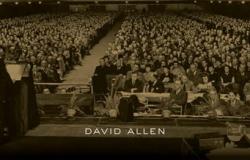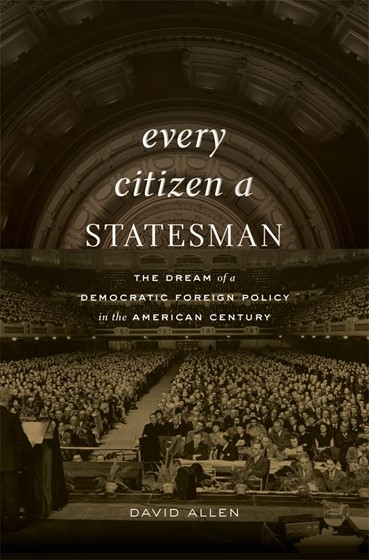Book Review - Every Citizen a Statesman: The Dream of a Democratic Foreign Policy in the American Century

Every Citizen a Statesman: The Dream of a Democratic Foreign Policy in the American Century by David Allen. Cambridge: Harvard University Press, 2023. 344 pp. £39.95 hardcover 9780674248984
On April 2, 1917, President Woodrow Wilson asked Congress to declare war on Germany. He claimed that the United States needed to enter World War I because “The world must be made safe for democracy.”[i] By April 6, both the House of Representatives and the Senate approved a declaration of war. Yet, as Wilson’s congressional critics noted, democracy required the input of ordinary citizens. Progressive Republican Robert LaFollette, a senator from Wisconsin, made this point on the floor of the Senate on April 4. “In a sense that this war is being forced upon our people without their knowing why and without their approval, and that wars are usually forced upon all peoples in the same way,” LaFollette declared, “there is some truth in this statement.”[ii] As world leaders discussed the postwar peace in 1918, journalist Paul Kellogg helped lay the foundation for the League of Free Nations Association, which became the Foreign Policy Association (FPA) in 1923. As David Allen documents in his wide-ranging and extraordinary study of the FPA and its struggle to bring policymaking to the masses, the progressive ideals that undergirded LaFollette’s opposition to World War I maintained a strong presence in the United States before the arrival of the Cold War. Allen illustrates that “until the frostiest years of the Cold War, the general premise remained that the United States must not conduct its policy in the secretive, insular manner of a traditional, European foreign office” (5).
 A diversity of voices offered strikingly different views on how to democratize foreign policy in the post-World War I era. Former secretary of state Elihu Root’s belief that the masses, growing ever more expansive with the ratification of the Nineteenth Amendment, which granted women the right to vote, needed guidance from a select few influenced the founders of the Council on Foreign Relations in 1921. In comparison to what Allen calls the “aristocratic theory of public opinion” prevalent among Council members, the FPA offered a more expansive vision of a democratic foreign policy (24). That said, in its early years, the Association primarily reached out to the public through exclusive luncheons meant to spur debate over various foreign policy issues. As Allen writes, “high society was its first target,” even if it allowed women under its big tent (31). Even when the Association beamed the proceedings over the radio, the prohibitive cost of the technology its limited reach precluded widespread listening. However, by 1928, fourteen branches existed, with each local Association holding their own luncheons.
A diversity of voices offered strikingly different views on how to democratize foreign policy in the post-World War I era. Former secretary of state Elihu Root’s belief that the masses, growing ever more expansive with the ratification of the Nineteenth Amendment, which granted women the right to vote, needed guidance from a select few influenced the founders of the Council on Foreign Relations in 1921. In comparison to what Allen calls the “aristocratic theory of public opinion” prevalent among Council members, the FPA offered a more expansive vision of a democratic foreign policy (24). That said, in its early years, the Association primarily reached out to the public through exclusive luncheons meant to spur debate over various foreign policy issues. As Allen writes, “high society was its first target,” even if it allowed women under its big tent (31). Even when the Association beamed the proceedings over the radio, the prohibitive cost of the technology its limited reach precluded widespread listening. However, by 1928, fourteen branches existed, with each local Association holding their own luncheons.
Even as the FPA promoted a more democratic foreign policy, Allen highlights the tension underlying the Association’s program, which sought to balance the need for expert guidance with participatory democracy. From the 1920s through the 1960s, the Association received funds from the Rockefeller, Carnegie, and Ford foundations. Consequently, it adopted the philosophy favored by these philanthropies, which relied on non-partisan experts using the scientific method to promote peace. Yet, at least early on, such thinking did not exclude the masses. Rather, the experts in policy organizations like the Association would disseminate knowledge to create an informed public. To this end, with funding from the Rockefeller Foundation, the Association put out its first Editorial Information Service issue, which became Foreign Policy Reports in 1931. This publication allowed the Association to profess its devotion more easily to unbiased and fact-based knowledge, which eventually helped it gain a hearing in official government circles and among the media. Objectivity became the centerpiece of the Association’s publications, even as Harvard University lecturer Raymond Buell, who became director of research in 1927, criticized such an approach. Nonetheless, under his leadership, the Reports focused on “dispensing facts to the growing number of Americans who had a professional stake in foreign affairs,” whether in universities, research institutes, or in the government (59).
Contemporary discussions about adult education influenced the Association’s understanding of its role. The prospect of discussions between ordinary Americans and elites, with the latter serving as discussion leaders, appealed to Buell and other Association members who sought a symbiotic relationship between experts and the public. In fact, the lackluster response to domestic and international crises in the 1930s by U.S. policymakers convinced Buell of the need to focus greater attention on ordinary Americans. To this end, the Association published a Headline Books series meant to introduce the general reader to complex issues. At the end of the day, few citizens purchased these books.
With the onset of World War II, the FPA changed course as it aimed to influence public debates surrounding U.S. involvement in the worsening conflict. In the years preceding Hitler’s invasion of Poland in 1939, the Association possessed a “commitment to freedom of speech,” in the words of Allen. Thus, its staff, as well as the speakers it invited to participate in its events, came from across the spectrum to promote internationalism, interventionism, and neutrality. The devotion to objectivity disappeared as the belief grew within the Association that “the public required firmer guidance,” according to Allen (77-78). Whereas the Association’s luncheons once offered multiple speakers from various perspectives, the non-interventionist approach no longer received a hearing.
As it followed this new approach, the Association found its influence spreading among government officials. However, the FPA struggled to find a way to mesh its own proclivity for a democratic foreign policy with the government’s growing interest in propaganda to control the masses. Moreover, following World War II, both the Rockefeller Foundation and the Carnegie Corporation cut off funding for the Association. These philanthropies began funneling their money into research institutes uninterested in educating the average citizen. As a result, think tanks like the RAND Corporation found themselves flush with funds, as they used their knowledge in service to the U.S. government.
The Association faced financial and organizational hurdles as philanthropic funding dried up, membership declined, and its leadership either died or went to greener pastures in and outside of government. Thus, the FPA charted a new path forward with its Great Decisions program in Portland, which involved groups of roughly a dozen citizens meeting approximately eighty to ninety times during an initial run from February to April 1955. In doing so, the Association “counterattacked,” in the words of Allen, the notion popular among contemporary social scientists, such as Robert Dahl and Gabriel Almond, that attempts at creating a democratic foreign policy were futile (174). In its first year as a national program, Great Decisions reached fifty-four towns and cities in forty-three states, involving some sixty-five hundred participants. By the end of the decade, eighty thousand citizens had taken part in Great Decisions. Yet, very few exchanges took place between these ordinary people and the elites in Washington. Even the ballots filled out by participants to denote their views on foreign policy issues turned into what Allen describes as a “performative exercise” (195). Most often, local branches did not even send the results to the Association headquarters. Additionally, the State Department, though supportive of Great Decisions, praising it in publications and sending diplomats to speak at its forums, did not reply to participants who felt energized enough to send letters. Moreover, Great Decisions continued to attract the usual crowd, meaning the white, educated middle-class, a very limited slice of the American citizenry. The FPA’s decline continued into the 1960s. When Samuel P. Hayes, a social psychologist and expert in public opinion, became the Association’s president in 1962, Allen suggests that it represented the acceptance by the FPA of “the primacy of [1]policymakers” (209). Under his direction, the Association turned away from the general public in favor of what Allen describes as a more “exclusive public” (211).
A recurring theme throughout Allen’s book is the involvement of women in what is normally a male-dominated field. Even as the FPA owed its start largely to the efforts of pacifist and suffragist women, who provided the early Association with institutional support and expertise, “male internationalists,” in the words of Allen, eventually took it over (10). Association branches opened many doors for women, but mainly in organizational roles with glass ceilings. For instance, despite the presence of many women in the Boston branch, no woman gave a lecture in the series organized by the group from 1927 through early 1930. While women pop up periodically in Allen’s story, I would like to see them given even more attention. For instance, did the inclusion of so many women help the Association form ties with the numerous women’s pacifist and suffragist groups? Did the burgeoning women’s rights movement lead to changes within the Association? Notwithstanding this minor quibble, Allen’s book is a wonderful contribution that deserves a wide audience.
Dr. Brian S. Mueller teaches history at the University of Wisconsin-Milwaukee.
Notes
[i] Woodrow Wilson, Address to a Joint Session of Congress Requesting a Declaration of War Against Germany Online by Gerhard Peters and John T. Woolley, The American Presidency Project https://www.presidency.ucsb.edu/node/207620
[ii] 65th Congress, Congressional Record (Senate), 55, pt. 1, 225.


